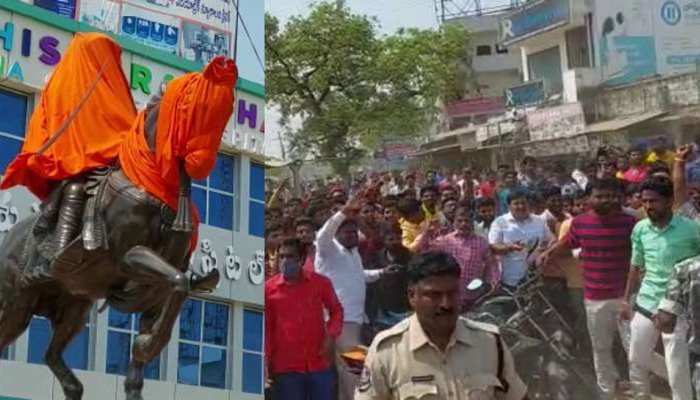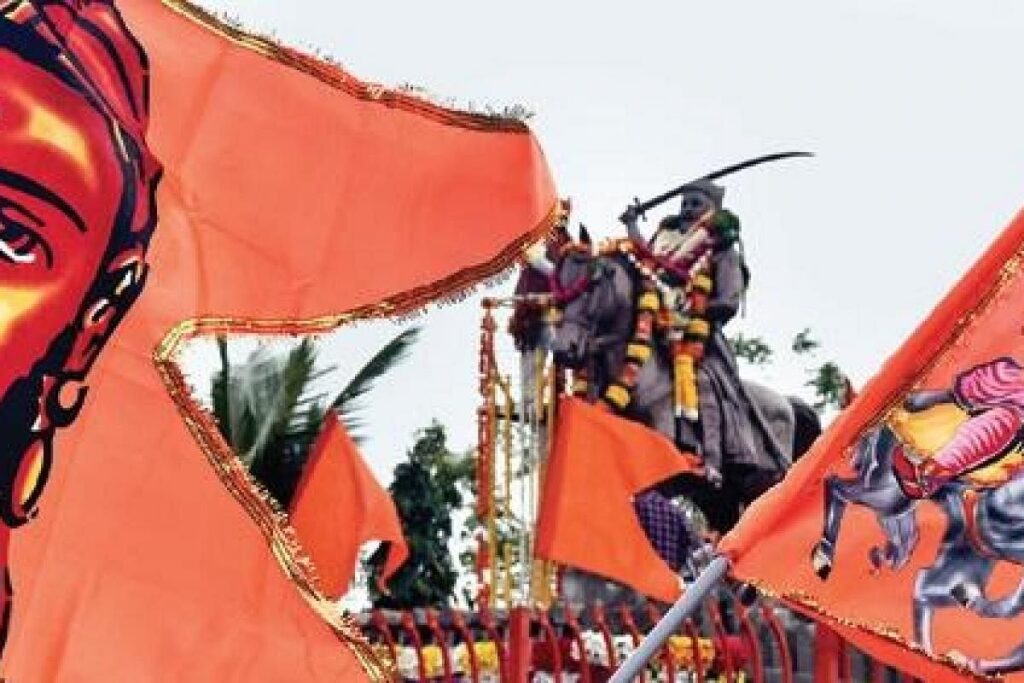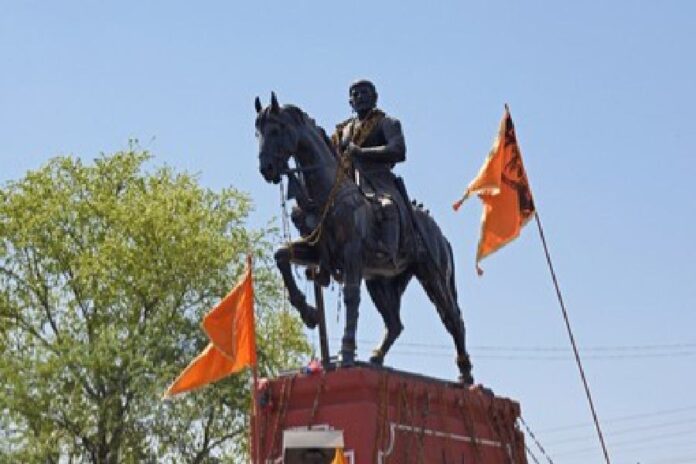The Bharatiya Janata Party (BJP) and it’s affiliates are trying hard to capture the pulse of Telangana people to gain momentum to get domination in the remote areas. As #KhabarLive travelled through the villages in northern Telangana, the picture that emerged was a consolidation of Backward Class castes by the BJP and its affiliates.

A picture of a Chatrapathi Shivaji statue wrapped in an orange cloth went viral in Telangana last week. The picture was from Bodhan, a small town in northern Telangana’s Nizamabad that houses fewer than one lakh people. Bodhan faced prohibitory orders under Section 144 of the IPC for over a week after communal clashes between a section of Hindus and Muslims broke out over the statue.
The Bodhan incident made news because of the outbreak of violence but tension has been building below the surface in the region for some time now. If one zooms out a little, and moves past Bodhan to other villages and towns in northern Telangana, one sees scores of newly installed statues of Shivaji.
In many cases, they seem to be positioned strategically to tower over Ambedkar statues which have been ubiquitous since the 1980’s in every village and town of Telangana.
Why is there a sudden outpouring of support in Telangana for Shivaji, whose appeal is much more palpable in neighbouring Maharashtra?
As #KhabarLive travelled through the villages in northern Telangana, the picture that emerged was a consolidation of Backward Class castes by the BJP and its affiliates. Shivaji, the symbol of Marathi pride, is the tool that Hindutva groups in the state are using for their long-term political project involving the Telugu-speaking dominant castes in these border districts.
In Bodhan, the Shivaji statue was installed by a Shiv Sena member, Gopi Kishan, near the town’s BR Ambedkar square on March 24. The statue was installed overnight, close to the pre-existing statue of Vivekananda, and the Telangana martyrs’ stupa. The installation neither had the requisite permissions according to district authorities and the police, nor were people in the area informed that a new statue was coming up there. The installation of the statue caused tensions between two groups — Hindus affiliated with BJP, Shiv Sena and Hindu Vahini on one side; and on the other, Muslims affiliated to AIMIM and TRS on the other, along with other members of the parties. Stone pelting between the groups led to police lathi charge and a curfew in the town. An ACP-rank police officer told #KhabarLive that over 25 people have been arrested for their role in the incident, adding that more arrests are likely.

Meanwhile, the politics continues and new details emerge every day: AIMIM wants a statue of Tipu Sultan in the town; BJP leaders met the people arrested for triggering the stone pelting and tensions over the statue, in jail; a TRS leader in the town is said to be in cahoots with Gopi Kishen for the installation of the statue.
And even as the situation in Bodhan was turning communal after March 24 when the Shivaji statue was installed, BJP and other rightwing organisations started social media campaigns portraying the opposition to the Shivaji statue in Bodhan as a threat to Hindus from Muslims.
Local BJP leader and Ex Municipal Floor Leader of Bodhan, Ramaraju tells #KhabarLive, “A section from the minority community has tried to stop the Shivaji statue installation despite the municipal council having passed a resolution in favour of Shivaji statue installation.” When asked about the relevance of Shivaji’s statue in Telangana, he says, “We put up statues of Mahapurush (great men) to celebrate the spirit of their acts and remember their greatness.”
Another Shivaji statue was recently unveiled in the Dharpally RTC bus stand premises without permission, and a similar standoff between TRS and BJP cadres resulted in injuries to people including the police. The friction began as TRS activists decided to unveil the statue objecting to some members of the organising committee extending an invitation to BJP MP Arvind Dharmapuri.
Shivaji’s march
The BJP and Hindu rightwing organisations claim they have no motive other than celebrating the spirit of Chatrapathi Shivaji, but what is appearing on the ground suggests much more.
Scores of statues of Chatrapati Shivaji, whose historical significance mainly lies in Maharashtra, have been installed across northern Telangana’s erstwhile districts of Nizamabad, Karimnagar, Medak and parts of Adilabad. The statues find place in crowded squares in small towns, and even in villages with less than 2,000 residents. The arrangements for the installation are done by local youngsters. We observed that the organisers of the Shivaji statue unveilings are usually from Backward Class castes like Munnuru Kapu, Mudhiraj, Yadav, Goud and other dominant, agrarian castes; the organising teams also include socially powerful Reddys in many cases. And in every instance, the installation and events surrounding it are backed by Hindu rightwing groups like Bajrang Dal, Hindu Vahini and other BJP affiliates.
These statues occupy village squares, with no objection from the Grama Panchayats or revenue authorities; but if the local Dalit youths try to set up an Ambedkar statue in the village square, they are threatened or asked to erect it in their locality.
And if there is already an Ambedkar statue in the village square, the Shivaji statues that are installed are invariably taller and stronger — a visual representation of the caste hierarchy, and to dominate the space.
Around the installation, there are messages and videos which stoke communal rivalry that are posted in village WhatsApp groups, that go unquestioned. A glance at some of the Facebook posts in the backdrop of the Bodhan incident shows how much hatred and enmity was sparked by Hindutva proponents. One viral video claimed that hundreds of “Hindus” are rallying to Bodhan from bordering Maharashtra. However, Facebook flagged the video as “False information”. Meanwhile, BJP leaders like Arvind Dharmapuri have warned of ‘consequences’ if the authorities touch the statue of the Shivaji in Bodhan.
Hindutva ploy
The erstwhile Nizamabad district contains over 15.35% of the Muslim population of Telangana, standing next to Hyderabad which has 45% of the state’s Muslim population. Nizamabad shares borders with Maharashtra, and is known for its communal sensitivity. The case is the same with other districts like Adilabad, Medak, Karimnagar, Rangareddy and Mahbubnagar, where there is a seizable Muslim population, mainly concentrated in urban pockets.

Manikanta Pallikonda, an Ambedkarite research scholar, sees mobilisation around Shivaji statues as a deliberate ploy by the BJP. He observes, “They are speeding this up in these districts especially because they have more Muslim population, and the BJP thinks electorally they can consolidate and turn their Lok Sabha winnings into Assembly election victories. Bajrang Dal has also been working among the youth here for many years. This, they do not only in the name of Bajrang Dal but also with the special committees they form during Dassara, Ganesh festival — they are more aggressive.”
During the famous Telangana state festival of Bathukamma, the folk rela songs are also being given Hindu colour, in the form of dandiya performances which are prevalent in Gujarat and other northern states. The Hindu rightwing also constantly engages people with their propaganda through music and several other popular means; the lyrics of the songs which are in typical Telangana slang, attempt to display ‘nationalism’ while heavily emphasising on communal symbolism.
Pallikonda further notes, “They want to create fear among minorities firstly, not with the Shivaji statue alone but through all the aggressive activities they do. These incidents don’t just further the polarisation, they necessarily internalise a sense of hatred among the common public. Such is the propaganda carried in all sorts of media, especially in the regional language. Through this, ignorant and innocent citizens, mostly from Bahujan castes, are pushed more towards hyper religiosity with a tilt towards Hindutva. There is no single community that is left in this propaganda process and in manufacturing hatred — at least through social media.”
The Justice Sri Krishna Committee, which was appointed in the backdrop of the separate Telangana movement, had said that the according of a separate state may give rise to “left wing extremism” and “communal fundamentalism”; however the former has lost its ground in Telangana, but the latter seems to be visibly gaining ground. The unabated bigotry that is spread through WhatsApp groups and other social media platforms, beside incidents like Bodhan or Bhainsa in Nirmal district which saw two episodes of communal clashes in the last two years, are the fuel.
Narratives of Shivaji’s life
There are several narratives around Shivaji’s life and legacy, the most popular being the communal one. Hindu rightwing projects him as a ruler who hated Muslims; but other scholars contest this claim, and say he was secular king from a lowered caste who respected other religions, and say his portrayed Kshatriya identity is contestable.
In some pockets of erstwhile Medak and Nizamabad, Adilabad, the Arey Kshatriya or Arya Kshatriya community, a Backward Class (BC) caste group which is believed to have migrated from Maharashtra, claim Shivaji as their own and say they hail from his community.
The youths of other landholding peasant BC communities like Munnuru Kapu, Yadav, Mudhiraj, Goud, and dominant castes like Reddys too, organise around Hindu culture and festivals. This consolidation sometimes makes it easy to stitch together the scene. Despite looking like apolitical events, such consolidation gives birth to sentiments among people that are favourable for the BJP and other right wing groups.
In Telangana, BJP is trying to make inroads by mobilising BCs; of the four MPs from the party in the state, two hail from the Munnuru Kapu caste. BJP earlier demanded a BC Bandhu scheme in line with the Dalit Bandhu scheme which provides Rs 10 lakh financial assistance to each Dalit family in the state. While the BJP doesn’t oppose Dalit Bandhu openly or explicitly, the demand for a BC Bandhu is a move to subtly hint to BCs in the state that they are being ignored while Dalits are being prioritised.
The ruling TRS party too has realised that it doesn’t augur well if they detach themselves from participating in the growing Shivaji symbolism. Earlier in the last month, State Finance Minister Harish Rao, participating in a Shivaji statue unveiling function in Basara, a temple town Bhainsa subdivision of Nirmal, asserted that Shivaji is an inspiration for ‘religious harmony’ in contrast to constant right wing propagation.
The right wing is putting forth an imagery of Shivaji to orchestrate a political calculation at the cost of the social fabric by “otherising” Muslims while convincingly setting aside the history that emphasises his secular legacy. Shivaji was a central figure in the anti-caste discourse of Jyotirao Phule who hailed the non-Brahmin emperor as the greatest Shudra contender to Brahminism.
A very different narrative is being used by the Sangh in its statue installation campaign in Telangana where a new imaginary Shivaji is being valourised as a Hindu emperor who took on Muslims. #KhabarLive #hydnews







